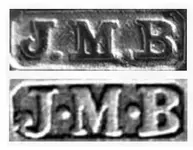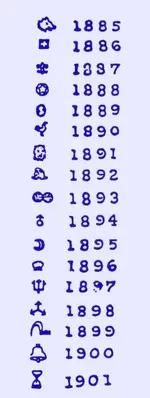The JMB stands for John Millward Banks. Firm established in 1863 in Birmingham with manufacturing premises at 6 Northampton Street, Birmingham and Showroom at 12, 14 Beake Street, Regent Street, London. In 1900 c. the firm name was changed to J.M. Banks & Co. The business was closed in 1926 c.
The anchor means Birmingham:
View attachment 1935658
That particular "A"
might be 1908:
View attachment 1935659
OR... that cross-looking thing might mean 1886 (as seen in the above image, plus this one):
View attachment 1935660
That's about all I can tell after 10 minutes on the internet.

Sorry, but I have to disagree with your conclusions from “10 minutes on the internet”, which pulls together completely unrelated pieces of information.
The dates and location for John Millward Banks are correct, but there’s no record of him having registered “JM over B in a shield”. His known marks have the initials in a row within a cartouche with chamfered corners, and with stops between the initials:

An “anchor” mark only reliably indicates “Birmingham” (England) when it’s part of our mandatory hallmark set on silver, which this is not. There’s no sterling mark on this piece. Elsewhere, it had wide use on pieces which may or may not be from Birmingham and was widely copied as a “pseudo-hallmark”, including on non-silver American flatware.
The second and third pictures have no relevance to John Millward Banks, nor any other English maker, whether in Birmingham or not. Both pictures show date codes used by Gorham in America (Providence, Rhode Island). Those codes were not used in England, nor by other American makers. They’re unique to Gorham. The date “letter” you have suggested might be for 1908 is not a letter A, but a pair of compasses (the Gorham mark, not the one on the ladle). The cross-like mark on the ladle has only a passing resemblance to that used by Gorham.
Although Gorham were one of many American makers that borrowed the Birmingham anchor as part of a pseudo-hallmark set, the marks on the ladle are in any case not for Gorham.
Having said that, I don’t actually know who the maker might be. There are still dozens of smaller makers on both sides of the pond whose marks are poorly documented. The pattern doesn’t help much. It’s a generic tipped “fiddleback” with fins on the shoulders which didn’t appear in England until about 1800 and then about 10 years later in America. I suspect it’s non-silver “nickel-silver” which was in use “as-is” in England from about 1832 and then electro-plated from about 1840 (for America, add on a year or so).







